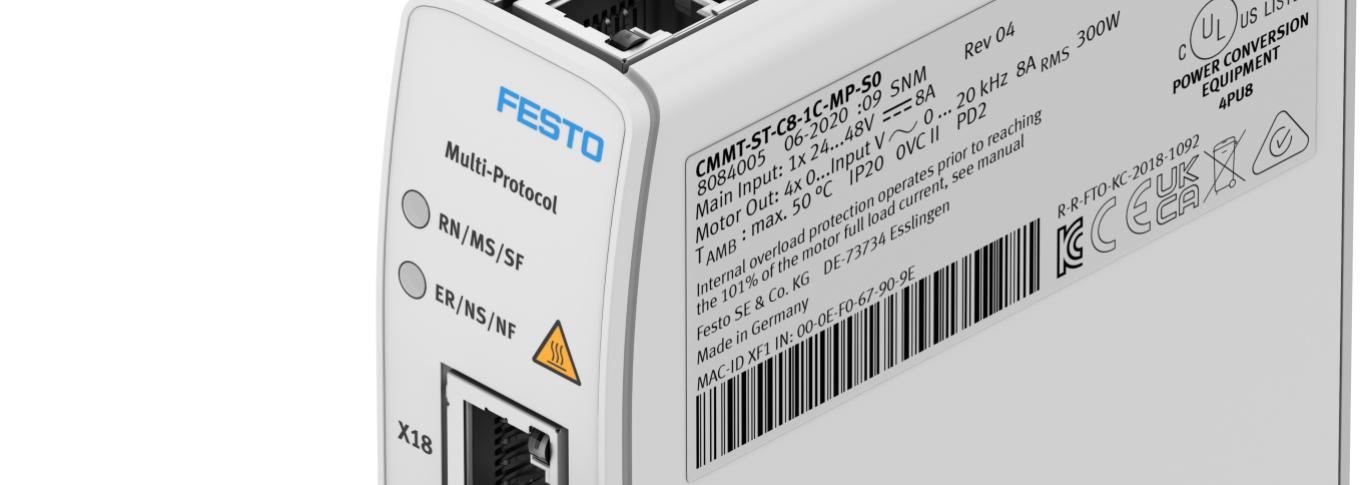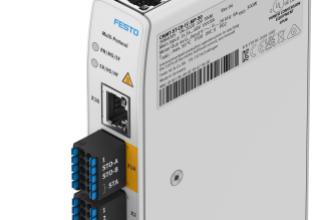
New CMMT-ST from Festo offers big savings
Machine builders no longer need to choose between a stepper or servo drive, thanks to the CMMT-ST from Festo. This new extra low voltage servo drive is capable of open or closed loop positioning, which effectively bridges the gap between stepper and servo drives. This means the user can tailor the CMMT-ST to suit the needs of the application and reap the benefits of both control formats.
Electric Drives Product Marketing Manager, Josh Roberts says: “The high dynamics and controllability of servo control loops can be useful in many applications, but there can be other times where the pulse, lock and stay characteristics of a stepper are the better choice. Our new CMMT-ST offers an opportunity for automation machine builders to access the best of both worlds and comes with free software for ease of programming.”
The CMMT-ST drops below the power class (300 W nominal) of the Festo CMMT-AS standard range of servo drives but shares the same control integration and function blocks, which means significant cost reductions can be achieved by combining the two types of drives within one system.
Termed ‘extra-low’ voltage because they work at 24 or 48VDC, this new generation of controllers has a raft of new features that sets them apart from previous Festo devices and from the competition. For example, the CMMT-ST has a micro-controller which is three times more powerful than previous models. This creates performance user advantages such as multi-protocol fieldbus compatibility, field weakening, energy management, auto-tuning and U/f open loop control. It also features an integrated webserver, which is an advanced feature for a low-cost device. This enables the easy transfer of data to and from the servo drive for fast, simple set-up, diagnostics and file transfers.
Within the CMMT-ST servo drive is the capability to communicate instantly to more than 75% of major fieldbus systems (including PROFINET, EtherCAT, EtherNet IP and Modbus), either through simple DIP switch settings, software set-up or auto-recognition. This means no changes to electrical designs, cabinet layout or wiring when swapping between control architectures, which is a time-consuming and expensive exercise for special purpose machine builders adapting to end-user specifications. It also means less stocked or service parts and less parts for installers and service technicians to become familiar with.
Field weakening sounds counter intuitive for a user benefit; however, it enables the connected motors to achieve higher maximum speeds or torques. For example, at low torques the maximum speed increases from 1,600 to 2,300 rpm - an increase of 44%. Therefore, there is the opportunity to select a smaller, lower cost motor to perform the same task.
Mechanically the CMMT-ST very efficiently packages advanced electronics within a robust enclosure with good EMC protection. An earthing fin shields the encoder feedback cabling, protecting the drive within ‘noisy’ environments on industrial machinery. Connectivity for braking resistors enables efficient energy management, soaking up the energy spikes and increasing the drive’s peak performance characteristics. A further energy saving option is to use the DC link sharing energy peaks between different drives within a system. For a compact drive which is only 144mm high, 88mm deep and 27mm wide it can manage an impressive nominal current of 8A and up to 20A peak for limited durations (3 sec. max.) for maximum acceleration or de-acceleration peaks within a positioning cycle.
Concludes Josh Roberts: “With a list price of under £500 and free of charge programming software, the CMMT-ST offers big savings for machine builders and users; particularly in applications where the drives are currently over-specified to combat the compatibility and control issues usually associated with mixing drives within a single control system. The CMMT family of pure servo drives (AS) and open/closed loop extra-low servo drives (ST) is an ideal combination that overcomes these challenges.”

